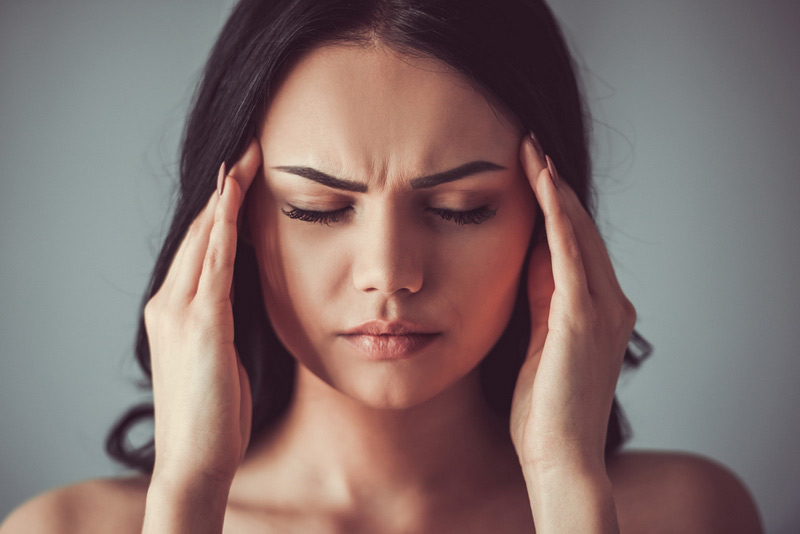
1 in 7 Americans – about 15 percent of the population – suffer from migraines or headaches at least once a year. In fact, headaches remain one of the leading causes of doctor visits in the U.S. (1)
While this might come as a shock to some, those suffering from migraines know that the pain can often be scary enough to run to the doctor.
But are these pains just random, or do they have a specific cause?
What Causes Headaches?
Headaches can be caused by any number of things, including:
- Stress
- Diet
- Nutrient deficiencies
- Dehydration
- Spinal alignment
- Sinus infections
- Environmental pollution
- Food sensitivity or allergy
To get a better understanding of what might be causing your headaches, it helps to become familiar with the different types of headaches.
Tension Headaches
Tension headaches are the result of – you guessed it – tension and stress. They can often become chronic if you experience daily stress, and often feel like a consistent throbbing. You might notice your neck and shoulders are also tight when you have a tension headache.
Sinus Headaches
If you find yourself pinching the bridge of your nose when you have a headache, you might find that your sinuses are to blame. Sinuses can become inflamed and cause pain around your eyes, nose, and forehead, and will sometimes be accompanied by puffy eyes and cheeks. Their cause can be sinus infections, but they can also be from food sensitivities or allergies or even gut problems.
Cluster Headaches
Cluster headaches are the type that can come on suddenly, causing an intense stabbing or burning pain. They can occur seemingly randomly over weeks then disappear for years. Their cause can be diet, nutrient, or stress-related.
Migraine Headaches
Migraines are the type of chronic headache that make you miss work and shut yourself away in a dark room. The pain can be either stabbing or throbbing and is usually accompanied by nausea and dizziness. The causes of migraines can range from mineral imbalances to food allergies, pollution, and eyestrain.
How Common Are Migraines and Headaches?

As mentioned earlier, migraines and headaches affect about 15 percent of the U.S. population, with females experiencing more migraines than males. They were also the fourth leading cause of visits to the emergency department (ED) as of 2009-2010. (2)
Symptoms and Risk Factors
Symptoms of headaches include:
- Dull, throbbing pain behind the eyes or back of the head
- Sharp, burning pain behind the eyes
- Head pain accompanied by nausea and dizziness
Risk factors for headaches:
- Excess stress
- Vitamin and mineral deficiencies
- Illness such as colds and sinus infections
- Eyestrain
- Back pain or spinal misalignment
- Hormone imbalance
- Environmental pollution from perfumes, household cleaners, smoke, and exhaust
- Food allergies and sensitivities
- Liver or detox problems
- Thyroid problems
8 Natural Ways to Get Rid of a Headache
Popping a pain pill might provide you with temporary relief, but it doesn’t address the root cause of your headaches. Plus, pain medications can also have nasty side effects, like increased risk of heart failure. (3)
Instead, try some of the remedies below to address the true cause of your headache pain while also providing natural, temporary relief.
1. Essential Oils

Both inhaling and applying essential oils topically can offer quick headache relief. Two of the best for headaches are peppermint and lavender, as they have been shown to have pain-relieving effects.
Peppermint oil in particular can help soothe muscle spasms and promote relaxation, which is great for tension headaches. It has been shown in studies to increase blood flow when applied to the forehead, while also reducing headache sensitivity. (4)
Lavender oil has sedative properties that help promote muscle relaxation, and has been shown to directly influence migraine headache pain. One study showed that 91 out of 129 migraine sufferers experienced relief after inhaling lavender essential oil. (5)
Next time you’re suffering from a headache, try diluting a few drops of lavender or peppermint essential oil in a carrier oil like coconut oil, almond oil or olive oil (a teaspoon or so), then massage it around your forehead, neck, and shoulders. Alternatively, you can try adding lavender or peppermint oil to an oil diffuser and inhaling deeply.
2. Herbal Remedies

Feverfew is an anti-inflammatory herb that has been used for centuries to treat fevers and migraines, among other ailments. One of the most promising aspects of this herb is its ability to prevent migraine attacks from happening in the first place. One study showed that participants who took feverfew daily prevented migraine attacks, while those on a placebo experienced an increase in severe headaches and nausea. (6) This shows that feverfew can indeed keep headaches at bay and is a great option if you find yourself suffering with recurring migraines.
Butterbur is another herb with anti-inflammatory properties that can help prevent migraines. Studies have shown that a daily supplement of 75 milligrams of butterbur extract can reduce migraine attacks by a whopping 45 percent in just four months. (7) This effect could be due to the ability of butterbur to regulate blood flow to the brain, relieving pressure.
3. Magnesium

Low magnesium levels could be the reason behind your recurring headaches. This critical mineral is one of the most abundant in your cells, and most of the population doesn’t get enough due to depleted soils. It helps regulate serotonin receptors and neurotransmitter release, and also works to soothe the nervous system (both functions can have an influence on headache pain).
Research has shown that magnesium deficiency is much more common in migraine sufferers than it is in others, and that supplementing orally should be a part of all migraine treatments. (8)
The most common side effect of supplementing with magnesium orally is diarrhea, but this can be avoided by reducing your dosage. If you don’t want to supplement, you can also up your magnesium by eating more leafy greens, squash, almonds, and raw cacao.
4. B Vitamins

B vitamins play a crucial role in helping your nervous system function properly while also regulating how it uses serotonin and norepinephrine. These chemicals and functions have been shown to play a role in the development of headaches, so it’s beneficial to ensure that you have adequate levels.
One study showed that a combination of vitamin B6, B12, and folic acid given to migraine sufferers resulted in fewer and less severe migraine attacks over the course of six months compared to a placebo. The B vitamin group also reported reduced migraine disability from 60 percent to just 30 percent over six months. (9)
If you suspect a B vitamin deficiency, try adding a B-complex to your supplement routine. Don’t be too worried about the dosage, since B vitamins are water soluble and the excess will be flushed out through your urine.
5. Avoid Processed Foods, Gluten, and Dairy

If you’re having recurring migraines, you might want to take a closer look at your diet. Aside from avoiding processed foods loaded with synthetic chemicals and GMOs, try dropping wheat and foods containing gluten for a few weeks.
Studies have found links between migraine headaches and celiac disease (a condition where a person cannot tolerate the gluten protein found in wheat), discovering that migraine headaches occur more often in those with celiac disease. (10) However, even if you don’t have the full-blown disease, you could still have a gluten sensitivity that triggers migraines.
Additionally, you can try eliminating dairy products, since lactose can be a major problem for many people. Substitute dairy milk for almond milk for a while and see how you feel.
6. Stress Management

There’s a reason tension headaches are one of the most common kinds. Stress and tension can bring on chronic headaches that last for days and are accompanied by tight neck and shoulder muscles.
One German study that followed participants for two years found that the more stress in a person’s life, the greater the frequency and severity of their headaches. On the flip side, those with the least amount of stress reported hardly any headaches. (11)
While it might seem difficult to decrease your stress levels, try to get into a daily stress management habit, like deep breathing exercises or 15 minutes of meditation.
If you’re not the sitting-still type, you can also try yoga, which has been found to decrease headache severity and frequency. For instance, a study out of Finland found that 60 women put in a 12-month stretching program experienced a 69 percent reduction in headache intensity. (12)
7. Acupuncture

Acupuncture is an ancient subset of Chinese medicine that focuses on regulating the body’s proper flow of energy.
Studies have shown that acupuncture is at least as effective as prescription medications in treating and preventing migraines, and has even been found to be “more effective than standard therapy for the treatment of tension headache.” (13)
8. Hydration

It’s also important to make sure that you’re adequately hydrated, since dehydration can sometimes cause your head to throb and lead to consistent headache problems. Drink plenty of water throughout the day and consume water-rich veggies and fruits like melons and cucumbers.
How much water do you need? While the answer is different for everyone, starting with eight glasses a day or half your body weight in ounces can be a good way to gauge if you ultimately need more or less.

